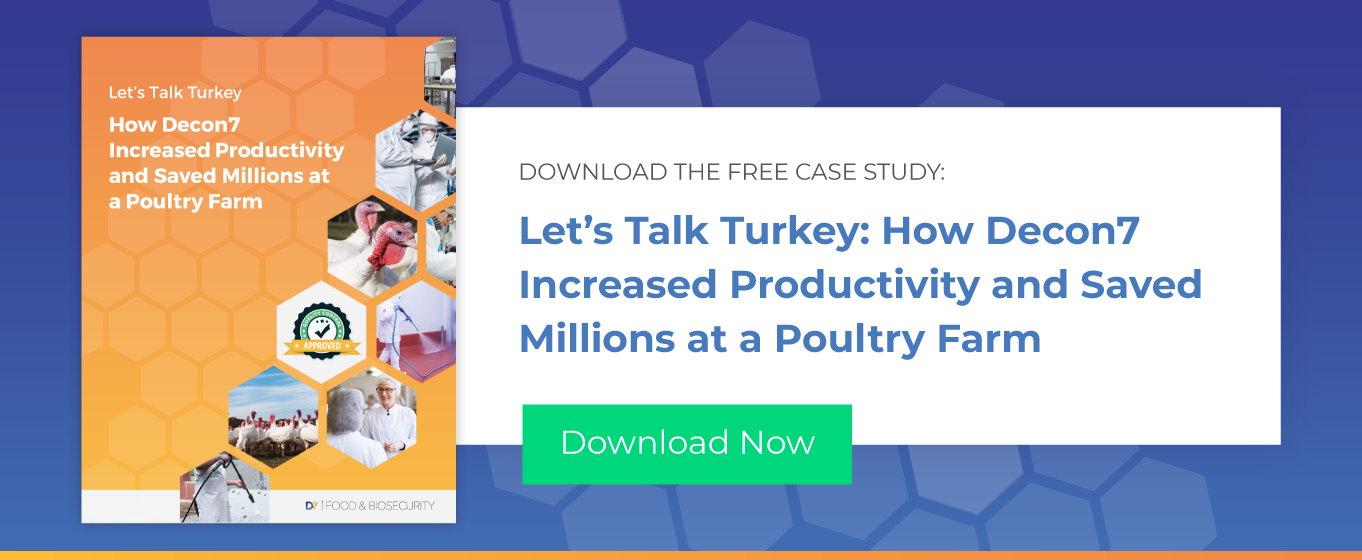Foam is quickly becoming the tool of choice for decontamination and sanitizing operations around the world. Recognized for its many advantages over liquids, foam is proven to be more effective in areas such as hazmat cleanup, fireground carcinogen reduction, and sanitation.. Its success in these areas has led food processors to consider foam for facility sanitation and decontamination because many of the benefits that foam offers in these contexts are also relevant in food safety applications.
The Benefits of Foam
Foam offers a range of advantages in multiple industries, especially in large facilities or when vertical surfaces must be treated. For example, one study highlighted the suitability of foam (compared to liquid) for high-volume facilities because of its stability, wetting, and hydrodynamic properties. Some of the additional benefits of foam include:
Longer Contact Time
When compared to a liquids, D7 foam maintains a longer wet contact time, which means that fewer applications are required and less concentrate is used. For FSQA managers, this potentially translates into lower product costs and less storage space required for sanitizing chemicals.
Less Burden on Personnel
Foam is also lighter than liquids, resulting in a longer throw distance. This allows the user to maintain a greater distance from the “threat” being addressed. In the case of food safety applications, this means that foaming equipment does not have to be transported as far, especially if longer hoses are used. This helps saves manpower and also makes the application process more efficient. Another benefit to food safety personnel is that foam weighs much less in the hose, reducing user fatigue and minimizing manpower requirements.
Visual Indicators
Compared to a liquid, foam provides a clear visual indication of which areas have been treated and which areas may have been missed. This ensures that every surface is addressed so that bacteria in a food processing facility can be reduced to a safe level. It also prevents personnel from spraying the same area twice, which contributes to cost savings.
Less Water Consumption
Applying foam requires less water than a liquid application, which results in less water consumption overall. In hazmat applications, foam also enables less: water damage, environmental damage due to drainage, and loss of natural resources. In food safety applications, foam adheres to vertical and inverted surfaces, which means that sanitizing chemicals do not have to be reapplied to achieve minimum contact times on ceilings and walls.
Smothering Effect
This is similar to the way certain foams can blanket and extinguish an open flame, when used in a decontamination, hazmat, or food safety scenario, the foam “blanket” keeps the target in place and minimizes its spread. If sanitization personnel walk through and area being sanitized, the foam transfers to their boots or equipment wheels and continues working, thus mitigating a common issue with cross-contamination.
Space-Filling Effect
When compared to liquid, foam is better able to fill vessels and cavities, This is important for food safety applications because of the need to clean pipes, tubing, and difficult-to-reach areas in and near equipment. As foam expands to fill the spaces surrounding it, it’s able to access areas that liquids might not reach.
The Benefits of CAFS
A Compressed Air Foam System (CAFS) is a standard pumping system that allows compressed air to be added to a solution to generate foam. The compressed air can be provided by a compressor or high pressure air bottle to propel the foam farther than blower-driven or standard water nozzles. Compressed air also produces a more stable foam structure than blower-driven or aspirated systems do.
Use the Power of Foam
The power of foam is well established in first response, hazmat, and decontamination applications. Because of this strong track record and the many benefits it offers, foam is now being more widely accepted in food safety applications. Of course, having the right combination of sanitizing chemicals and foam application technology is critical for achieving the desired results. Request a consultation with Decon7 to learn more about how you can harness the power of foam in your facility.


